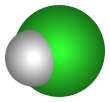
Back Waterstofchloried Afrikaans كلوريد الهيدروجين Arabic هیدروژن کولورید AZB Хлороводород Bulgarian হাইড্রোজেন ক্লোরাইড Bengali/Bangla Hlorovodik BS Clorur d'hidrogen Catalan Chlorovodík Czech Chlorwasserstoff German Υδροχλώριο Greek
| |||
| Names | |||
|---|---|---|---|
| IUPAC name
Hydrogen chloride[1]
| |||
| Systematic IUPAC name
Chlorane[2] | |||
| Other names
Hydrochloric acid gas
Hydrochloric gas Hydrochloride | |||
| Identifiers | |||
3D model (JSmol)
|
|||
| 1098214 | |||
| ChEBI | |||
| ChEMBL | |||
| ChemSpider | |||
| ECHA InfoCard | 100.028.723 | ||
| EC Number |
| ||
| 322 | |||
| KEGG | |||
| MeSH | Hydrochloric+acid | ||
PubChem CID
|
|||
| RTECS number |
| ||
| UNII | |||
| UN number | 1050 | ||
CompTox Dashboard (EPA)
|
|||
| |||
| |||
| Properties | |||
| HCl | |||
| Molar mass | 36.46 g/mol | ||
| Appearance | Colorless gas | ||
| Odor | pungent; sharp and burning | ||
| Density | 1.49 g/L[3] | ||
| Melting point | −114.22 °C (−173.60 °F; 158.93 K) | ||
| Boiling point | −85.05 °C (−121.09 °F; 188.10 K) | ||
| 823 g/L (0 °C) 720 g/L (20 °C) 561 g/L (60 °C) | |||
| Solubility | soluble in methanol, ethanol, ether and water | ||
| Vapor pressure | 4352 kPa (at 21.1 °C)[4] | ||
| Acidity (pKa) | −3.0;[5] −5.9 (±0.4)[6] | ||
| Basicity (pKb) | 17.0 | ||
| Conjugate acid | Chloronium | ||
| Conjugate base | Chloride | ||
Refractive index (nD)
|
1.0004456 (gas) 1.254 (liquid) | ||
| Viscosity | 0.311 cP (−100 °C) | ||
| Structure | |||
| linear | |||
| 1.05 D | |||
| Thermochemistry | |||
Heat capacity (C)
|
0.7981 J/(K·g) | ||
Std molar
entropy (S⦵298) |
186.902 J/(K·mol) | ||
Std enthalpy of
formation (ΔfH⦵298) |
−92.31 kJ/mol | ||
Std enthalpy of
combustion (ΔcH⦵298) |
−95.31 kJ/mol | ||
| Pharmacology | |||
| A09AB03 (WHO) B05XA13 (WHO) | |||
| Hazards | |||
| Occupational safety and health (OHS/OSH): | |||
Main hazards
|
Toxic, corrosive | ||
| GHS labelling: | |||
 
| |||
| Danger | |||
| H314, H331 | |||
| P261, P280, P303+P361+P353, P304+P340+P310, P305+P351+P338, P410+P403 | |||
| NFPA 704 (fire diamond) | |||
| Lethal dose or concentration (LD, LC): | |||
LD50 (median dose)
|
238 mg/kg (rat, oral) | ||
LC50 (median concentration)
|
3124 ppm (rat, 1 h) 1108 ppm (mouse, 1 h)[8] | ||
LCLo (lowest published)
|
1300 ppm (human, 30 min) 4416 ppm (rabbit, 30 min) 4416 ppm (guinea pig, 30 min) 3000 ppm (human, 5 min)[8] | ||
| NIOSH (US health exposure limits): | |||
PEL (Permissible)
|
C 5 ppm (7 mg/m3)[7] | ||
REL (Recommended)
|
C 5 ppm (7 mg/m3)[7] | ||
IDLH (Immediate danger)
|
50 ppm[7] | ||
| Safety data sheet (SDS) | JT Baker MSDS | ||
| Related compounds | |||
Related compounds
|
Hydrogen fluoride Hydrogen bromide Hydrogen iodide Hydrogen astatide | ||
Except where otherwise noted, data are given for materials in their standard state (at 25 °C [77 °F], 100 kPa).
| |||
The compound hydrogen chloride has the chemical formula HCl and as such is a hydrogen halide. At room temperature, it is a colorless gas, which forms white fumes of hydrochloric acid upon contact with atmospheric water vapor. Hydrogen chloride gas and hydrochloric acid are important in technology and industry. Hydrochloric acid, the aqueous solution of hydrogen chloride, is also commonly given the formula HCl.
- ^ "hydrogen chloride (CHEBI:17883)". Chemical Entities of Biological Interest (ChEBI). UK: European Bioinformatics Institute.
- ^ Favre, Henri A.; Powell, Warren H., eds. (2014). Nomenclature of Organic Chemistry: IUPAC Recommendations and Preferred Names 2013. Cambridge: The Royal Society of Chemistry. p. 131. ISBN 9781849733069.
- ^ Haynes, William M. (2010). Handbook of Chemistry and Physics (91 ed.). Boca Raton, Florida, USA: CRC Press. p. 4–67. ISBN 978-1-43982077-3.
- ^ Hydrogen Chloride. Gas Encyclopaedia. Air Liquide
- ^ Tipping, E.(2002) [1]. Cambridge University Press, 2004.
- ^ Trummal, A.; Lipping, L.; Kaljurand, I.; Koppel, I. A.; Leito, I. "Acidity of Strong Acids in Water and Dimethyl Sulfoxide" J. Phys. Chem. A. 2016, 120, 3663-3669. doi:10.1021/acs.jpca.6b02253
- ^ a b c NIOSH Pocket Guide to Chemical Hazards. "#0332". National Institute for Occupational Safety and Health (NIOSH).
- ^ a b "Hydrogen chloride". Immediately Dangerous to Life or Health Concentrations (IDLH). National Institute for Occupational Safety and Health (NIOSH).


